|
|
|
Sort Order |
|
|
|
Items / Page
|
|
|
|
|
|
|
| Srl | Item |
| 1 |
ID:
144691
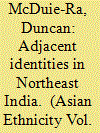

|
|
|
|
|
| Summary/Abstract |
In this article I explore the emergence, or re-emergence, of what I refer to as adjacent identities in response to changing circumstances for many Northeast communities in the last decade. In this paper I argue that it is important to consider seriously the ways in which communities in the region respond to the material and ideational changes to their lives in the present conjuncture by exploring adjacent ways of constructing identity in the face of, but not necessarily directly caused by, changing social, political, and economic circumstances. Massive investment in connectivity, which has transformed the Northeast from a frontier into a corridor, rapid urbanisation in the region, and an increase in migration out of the region have intensified the encounters between communities from the region and so-called ‘mainstream’ India and have brought different ethnic communities into closer daily proximity in the plural urban spaces of the region. The purpose of this article is to recognise adjacent ways of constructing identity in the face of, but not necessarily directly caused by, changing social, political, and economic circumstances. I provide two examples, shared Northeast identity in response to racism and broader ethnic inclusion based on shared cosmopolitanism. The former is a mass category in which virtually anyone from the Northeast can slip into, whereas the second relates specifically to speakers of a common language divided by international and internal borders.
|
|
|
|
|
|
|
|
|
|
|
|
|
|
|
|
| 2 |
ID:
144692
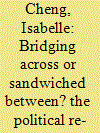

|
|
|
|
|
| Summary/Abstract |
This paper presents the ambiguous and complex political re-socialisation of Chinese immigrant women and their encounter with Taiwanese identity. Contrasting their conceptions before and after migration along a central-peripheral conceptual hierarchy, this paper elaborates how their nationalistic curiosity and understanding of democracy confronted Taiwanese identity in their everyday life. These daily, sometimes mundane, experiences manifested the contradictions between the conceptual hierarchy and the ethnic divide and partisan politics in Taiwan. Their political re-socialisation proved that this conceptual hierarchy was inadequate to deal with the Taiwanese-Mainlander divide and the anti-China sentiment. Political re-socialisation gained through daily life gradually fed into their reaction to the Taiwanese identity. Situated amongst the antagonism between Taiwan and China, they were locked in an in-between form of tension and their subjective identification would therefore be challenged by the mutual suspicion and exclusion of both sides which demand their singular and undivided loyalty.
|
|
|
|
|
|
|
|
|
|
|
|
|
|
|
|
| 3 |
ID:
144689
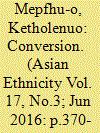

|
|
|
|
|
| Summary/Abstract |
This paper explores the role and impact of Christianity on the identity of the ‘self’ and the ‘other’ of the Naga converts. Christianity brings with it its own sets of cultures which are assimilated, appropriated or rejected by the converts. When an individual converts to Christianity, he/she assumes a new Christian identity whereof a new perception of ‘us’ and ‘them’ emerges. In the case of the Naga Hills, to be a ‘true’ convert, an individual was required to abandon the markers of his/her previous ‘heathen’ self. This was made into a requirement in order to receive baptism. This in turn involves a rejection of the previous lifestyle and the assumption of a new socio-cultural Christian identity. On the other hand, a non-convert looked upon conversion to Christianity not only as a threat to his/her self-identity but in some cases also to his/her Naga identity. This paper, therefore, seeks to understand the myriad impact of conversion on the individual convert, the reaction and responses of converts to their new Christian identity, their community at large and particularly to the non-converts.
|
|
|
|
|
|
|
|
|
|
|
|
|
|
|
|
| 4 |
ID:
144687
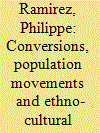

|
|
|
|
|
| Summary/Abstract |
In Northeast India, ethnic and religious conversions may be intimately associated. In the Assam–Meghalaya borderlands, conversions to Christianity throughout the twentieth century introduced a new factor in the interplay of spatial movements and cultural mutations, without fundamentally disrupting its basic principles. It is these complex dynamics that are described in this article through the history of three localities. Epidemics, religious conversions and cultural segmentation largely account for the present distribution of ethnicities.
|
|
|
|
|
|
|
|
|
|
|
|
|
|
|
|
| 5 |
ID:
144686


|
|
|
|
|
| Summary/Abstract |
This introduction presents the context and theoretical basis of fluidity of attachments in Northeast India. A large cultural, linguistic, and ethnic diversity, an international border situation, and various forms of unsettled relations with ‘mainstream India’ characterize Northeast India. These aspects form the frame of highly dynamic movements of identity and ethnicity formation. This special issue includes five papers that focus on these dynamics in terms of ‘fluidity’; they present new situations of shift between different layers of identification, re-signification of cultural practices in the process of their selection as emblems of groups‘ identity, changes in groups’ specific practices after religious conversion, and shifts from one identity to another. They show that shifts of ethnic identity are old processes in the region, whereas other levels of identification, such as lineages, clans, villages, and new ‘cosmopolitan’ identities coexist alongside ethnic identity, and gain particular salience in certain situations or points of time.
|
|
|
|
|
|
|
|
|
|
|
|
|
|
|
|
| 6 |
ID:
144690
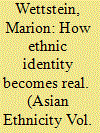

|
|
|
|
|
| Summary/Abstract |
Taking the material and performative world of the Nagas in Northeast India by way of example, this paper examines how identity, above all ‘ethnic’ identity, is manifested and gets incorporated into the understanding that people have of themselves. Following the shifts in identity over time by comparing ritual performances at the turn of the last century with present-day festivals in Nagaland, it is argued that the enactment of identity roles in public performative events provides a mechanism that makes identity concepts such as ‘ethnic identity’ real to people. The liminoid state during the performance enables individuals to live through identity roles emotionally, mentally, and somatically. It is suggested that the enactment of identity roles in public performances can thus be taken as a key to explain why and how identities can shift over time and between contexts.
|
|
|
|
|
|
|
|
|
|
|
|
|
|
|
|
| 7 |
ID:
144695
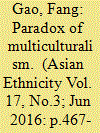

|
|
|
|
|
| Summary/Abstract |
China’s diverse minorities (shaoshu minzu) with various languages and cultures have much experience with the push and pull of homogenizing forces and indigenous cultures, representing a context-specific paradox of multiculturalism. Within the framework of Fei Xiaotong’s duoyuan yiti geju (plurality within unity), attempts have been made by the Chinese government in the provision of education for its ethnic minorities in order to balance ethnic diversity and national unity with an assumed pluralistic nature. Taking curriculum as a form of identity politics, this study provides insights into the role of the Chinese language curriculum in molding its minority readers’ identity that is embodied in an ambivalence of national-ethnic identity configuration. This study relies on the content analysis of official syllabus and 12 volumes of Chinese language textbooks for ethnic Korean children throughout the six years of primary schooling. It concludes that the language curriculum serves to reinforce its minority readers with a sense of nationalism, thereby rendering ethnic minority culture and value systems that can contribute to the development of ethnic identity under multiculturalism, almost invisible. The study’s findings call for a shift of focus in curricula from the indoctrination of the Chinese culturalism for social control to an increasing emphasis on a variety of cultural knowledge and the fostering of critical thinking and application of the cultural knowledge in an inclusive society.
|
|
|
|
|
|
|
|
|
|
|
|
|
|
|
|
| 8 |
ID:
144696
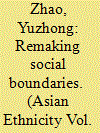

|
|
|
|
|
| Summary/Abstract |
In the historical transformation of the state, benzhu worship in the Erhai lake basin, northwest Yunnan, an esoteric Buddhist practice developed in the period of Nanzhao Kingdom, has been continually reconstructed by the state and local agencies. As a result, social boundaries between the Han Chinese and the ethnic ‘others’ living in this multi-ethnic southwestern frontier of China have been constantly remade. This paper, through a review of the state’s interpretations and local agencies’ negotiations and contentions of the meaning and practice of the worship, is mainly intended to revisit the social and cultural consequences incurred by the transformation of the state, and highlight, among other things, how local agencies, average villagers in particular, have cautiously yet ingeniously exercised their agency since the 1950s by appropriating or recasting national and international discourses on ethnicity and diversity to serve their own ends.
|
|
|
|
|
|
|
|
|
|
|
|
|
|
|
|
| 9 |
ID:
144694


|
|
|
|
|
| Summary/Abstract |
The purpose of this study is to examine the relationship between social and human capital regarding religious and language education among Japanese-Turkish families in Japan. The parents consider that it is their duty to pass on Islam to their children. Since Islamic education has a large influence on the children’s identity formation, parents give it a high priority. Concerning language, there is a tendency for the children to acquire Japanese as a primary language and English as a secondary language, despite the fathers’ desire to pass on Turkish. Turkish communities in Aichi Prefecture are composed of complex elements including place of origin, social and economic status, and ideologies of religious leaders followed. Intermarried families covered in this research obtain different social capital from each community. Even in the families who do not have the advantage of human capital, religious and language education is maintained in the community, where human and social capital mutually complement one another.
|
|
|
|
|
|
|
|
|
|
|
|
|
|
|
|
| 10 |
ID:
144688


|
|
|
|
|
| Summary/Abstract |
In the oral narratives of the Konyak and other Naga groups, the story of a woman is told who got married to an Ahom prince of the Assam plains and became a queen. Her name was Watlong. Recently a heated dispute between two Konyak villages arose regarding which village did Watlong actually originated from. Both villages claim her as the identification model by presenting stories, songs and objects of evidence handed down since generations. In this paper I follow the story of Watlong in its different variations in detail and suggest that the negotiation of identity among the (Konyak) Nagas, which is traditionally carried out through their specific oral narratives, is nowadays challenged through scriptualisation and notions of ‘the script’ mainly introduced by Christian mission.
|
|
|
|
|
|
|
|
|
|
|
|
|
|
|
|
| 11 |
ID:
144693
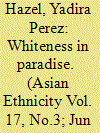

|
|
|
|
|
| Summary/Abstract |
In the 1950s, the Dominican government, under Rafael Trujillo, offered free land to Japanese immigrants to settle along the Dominico-Haitian border. The Japanese colonias, or agricultural colonies, were part of nation-building projects in the Dominican Republic (DR) and Japan, which positioned the Japanese colonias as the solution to both ‘the Haitian problem’ and overpopulation, respectively. However, over time the colonias failed, leaving many Japanese migrants disappointed and in need of navigating national identity between the two states. This article examines the ways in which the Japanese immigrants navigate shifting local and national interest, ideologies, and lived experience to file a legal civil action suit against the Japanese government for an unfound paradisiacal immigrant experience in the DR. The Japanese court-case provides a compelling case to explore how immigrants refashion national discourses of identity and collective legal action to hold natal government’s responsible for settlement while also embracing multiple national and ethno-racial identities in their new homeland.
|
|
|
|
|
|
|
|
|
|
|
|
|
|
|
|
|
|
|
|
|